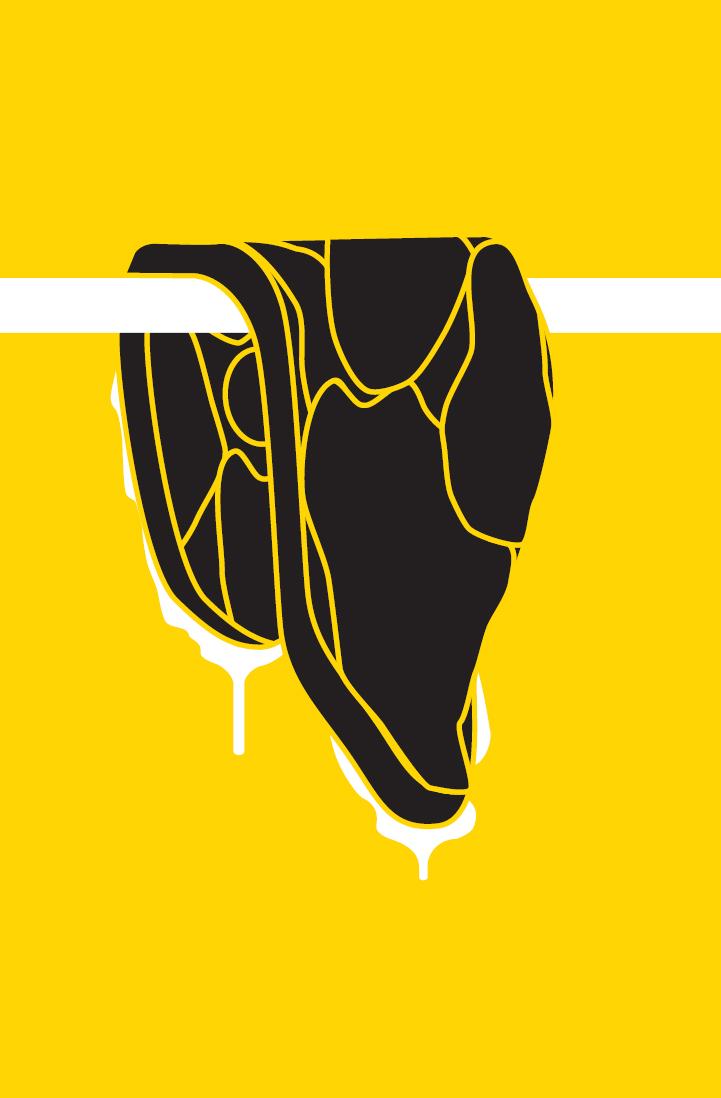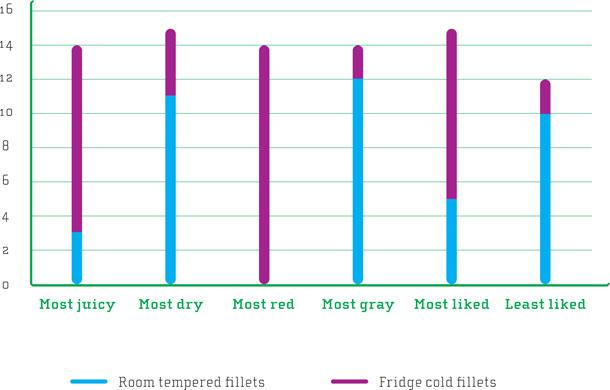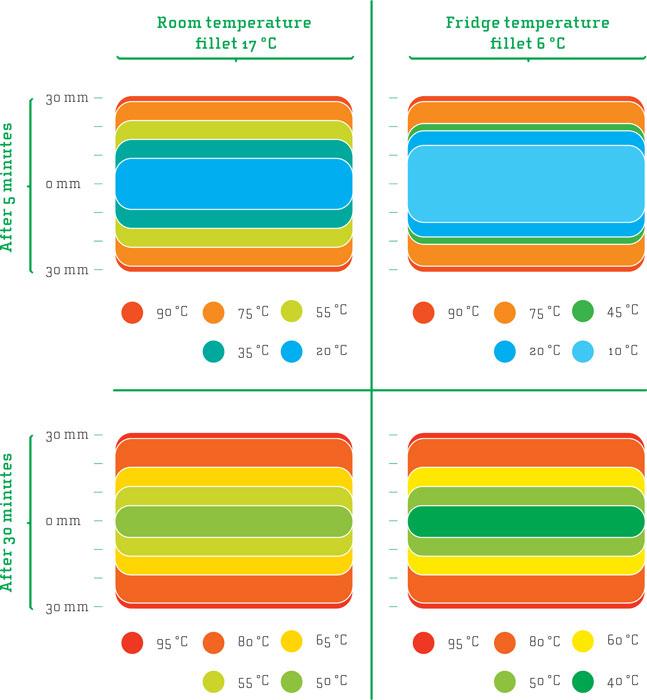
11
Tempering the Meat Before Cooking, …Or Maybe Not
One day chef Tatu presented us with a rather surprising question: “Is it really necessary to temper meat before cooking?” A surprising question coming from a chef because the answer is so obvious: yes, of course! Everyone surely knows that we should take the meat out of the fridge well in time before cooking, be it a roast or a steak. Indeed, this advice is written into every chef’s DNA, and it is simple common sense that meat will be more evenly cooked if the meat is not cold inside when placed in the oven, skillet, or pan. Cooking a piece of meat straight from the fridge should result in a thick outer layer of overcooked and drier meat before the center reaches the required temperature of, say, 55°C. Cold meat loses more juice during cooking than a properly tempered piece of meat. Or will it…? If this is not true after all, it could indeed be somewhat of a culinary bombshell.
But we have been surprised before, such as when Tatu asked if we really had to preheat the pan before frying fish (in the previous chapter). These types of statements are the most interesting ones, as we really need to challenge our own biases and preconceptions. As we have often experienced, there are factors we hadn’t thought of coming into play, showing us that the intuitive and linear way of thinking may often not be sufficient. The question called for a carefully designed experiment.
The cold meat experiment. We set up an experiment with two parallels to test if we could taste, or measure, any difference in pre-tempered meat and that taken straight from the fridge. We bought two pieces of beef tenderloin and cut both into two identical samples for each parallel. Duplicate samples were used to compensate for any differences between the pieces, one thicker (6 cm) and one thinner (5 cm) in each parallel. This should give a certain reproducibility; although, the experiment was not as rigorous as a proper scientific experiment.
All fillets were wrapped, and while two were put in the fridge, the other two were left in room temperature. A couple of hours later, we inserted cooking thermometers into the fillets and placed them together in the oven at 100°C. The tempered samples started at 17°C whereas the fridge cold ones started at 6°C. Each fillet was taken out of the oven when it had reached an internal temperature of 55°C. Thus, the cooking times were different, but the degree of cooking was the same for all fillets. After cooling, the fillets were weighed, carved, and blind tasted by 15 food workshop participants.
The participants were asked to select which of the four samples was the juiciest, the driest, the most red, and the most grey. And finally, they were asked to select which was the most and least preferred.
Surprising results ahead! In the blind tasting, the fridge cold fillets were evaluated as both most juicy and most red, and the room tempered ones were experienced as the most grey and dry (see the diagram). The more subjective votes for liking also went in favor of the fridge cold ones. Had we really falsified the claim that meat should be tempered before cooking? Such a controversial result needed more backing, and so it got from the more objective measures of cooking times and weight loss, or, in food terminology, cooking loss. The cooking times were 29 and 40 minutes for the room tempered ones, and 35 and 43 minutes for the fridge cold ones. The thin ones, as expected, were those requiring the shortest cooking time within each pair. The weighing indicated that the cooking loss was highest in the two tempered meat samples. They lost 14.1% (thinner) and 18.0% (thicker) of their weight during cooking whereas the cold meats lost 14.1% and 13.6%, respectively. The thick and cold piece of meat thus lost less of its weight during cooking. Allow us to repeat: the thickest of the fridge cold fillets had the lowest cooking loss of them all! To our knowledge, the direct opposite of what common kitchen wisdom would tell us. Of course, for proper research, we would need to repeat these experiments several times, calculate average values and do the statistics. It is worth reminding ourselves that the tasting result is partially a result according to today’s preferences, and preferences may change over time. If we had carried out the blind tasting 50 or 100 years ago, when many of our cooking rules were established, the votes for liking and thus cooking ideals might have been different.

^The diagram shows the results from blind tasting. The panel evaluated juiciness, color, and personal preferences. The results were pretty surprising!
Standard cooking rules, expert advice and common sense would tell us that the thickest and coldest fillet would be the one that lost the most water. Both because it cooked for a longer time and because the outer layers should expectedly become overheated for longer before the center reached the final temperature. After the first shock of being wrong we noticed that being wrong is a great way to learn more, keeping us on our toes at all times. Should we consider changing the instructions? Maybe not quite yet, but our results did indicate that this was a topic for further research. Our experimental setup was rather simple, as we used only one type of meat and one way of cooking. However, the unexpected results that we got both from objective weighing measurements and subjective sensory evaluation forced us to go into the literature. Interestingly, we didn’t find research on this.
So, we sat down to think over how heat spreads in meat. Unfortunately, we did not have fancy thermometers that could measure temperatures in different parts of the meat. However, we did have access to theoretical models on heat transfer in food during cooking such as the “Cook my meat calculator” developed by MIT students during a scientific cooking class in 2013. According to this model (see figure), the outer layers of tempered meat should heat up more rapidly than in the fridge cold meat. Throughout the whole cooking process, the room tempered meat would, according to the mathematical model, be warmer than the fridge cold meat, the latter catching up in the end. In the end, when the internal temperature had reached the targeted 55°C, the temperature distribution in both fillets were identical. So, they eventually ended up at the same final temperature, but the route to this temperature would not be the same. They would take somewhat different time, with a theoretically different “heating history” and the outer layers of the tempered meat would experience higher temperatures for a longer period of time compared to fridge cold meat.
Taking it one, or two, steps further. This should be good news. If the well-known cooking rule of tempering the meat is indeed incorrect, there would be a threefold benefit. You save time, the meat may come out juicier and you avoid leaving your meat at temperatures where microorganisms in the surface might multiply.
We didn’t test this for larger cuts, such as a whole leg of lamb or a whole ham, but the results brings to mind the traditional Finnish dish “frozen roast.” This is an exceptionally tender and juicy roast made by placing a frozen roast, preferably game such as moose or reindeer, in a 90–100°C oven and cook it overnight. The meat first thaws, and then is cooked slowly at low temperature. In the morning the roast is taken from the oven and immersed for several hours into a slightly salty stock made beforehand by simmering salt, spices and herbs in water. The meat absorbs the salty, aromatic water to give a tender and juicy piece of meat full of flavor. Apparently, cooking cold meat is not a new invention—we have just forgotten how good it can be.

^Theoretically calculated temperature distribution in fridge cold and tempered meat during cooking at 100°C. During heating to internal temperature 55°C (not shown), the fillets end up with a nearly identical temperature distribution. Illustration based on calculations using the “Cook my meat calculator” developed by students at MIT in Boston.
However, our experiment did not tell us anything about how the meat reacts if we want to fry it in a skillet like a steak. Our method of cooking the meat wrapped in plastic at 100°C is enough to make it reach the desired internal temperature, but not enough to let the Maillard reactions give a brown and tasty crust. In a later workshop we tested this and observed that meat placed in the skillet directly from the fridge develops a crust and color that is at least as nice as that of tempered meat. Actually, it was slightly darker and more even in the fridge cold fillet.
Apparently, the cold meat did not cool the skillet as often claimed (we made sure not to overload the skillet with meat). Maybe this reflects a general thermodynamic fact: the energy required to increase the temperature in water—the main component of meat—the 15–20°C differentiating tempered and fridge cold meat is negligible compared to the energy required to evaporate the already hot water in the meat, thus reaching temperatures allowing the Maillard browning reactions to occur. The more even color of the crust in the meat fried directly from the fridge may arise from the cold meat being more rigid than the tempered, allowing for fewer and smaller pockets of steam between the skillet surface and the meat. Indeed, chefs have tried frying steaks straight from the freezer reporting good results. Some of these are described on the Internet, among others in a video by America’s Test Kitchen.
We gladly agree that our tests are incomplete and require further experimenting before we would entirely dismiss such a long-lasting cooking rule as the one about tempering meat. So, we encourage everyone—amateurs, food professionals, and academics—to seize the opportunity and start experimenting with a systematic and open mind!